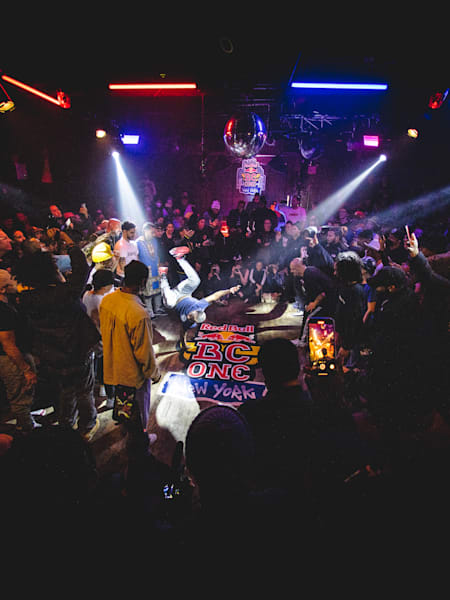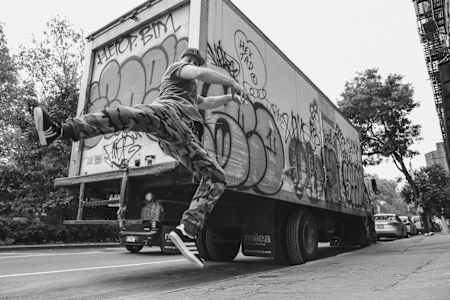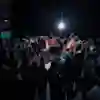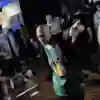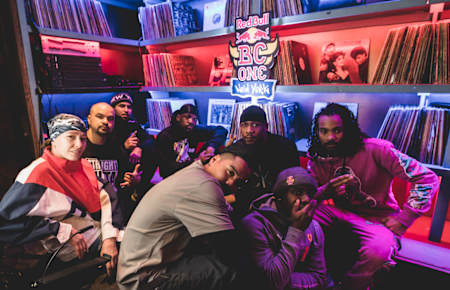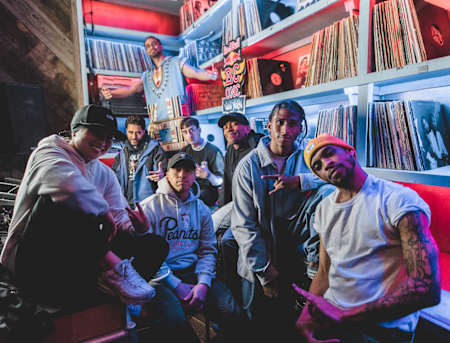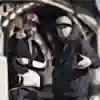
16 min
Queens and Brooklyn vs Bronx and Manhattan exhibition battle
Watch the exhibition crew battle at the Red Bull BC One NYC 2022 celebration.
When did you first start breaking?
I saw a move called the ‘Hellicopter’ in Brooklyn in 1978. I was walking past a pool hall and from across the street I saw someone doing it through a doorway. I was already doing the robot and popping because I was watching Soul Train. I’m an adopted kid so I was lucky because I divided my time between two boroughs which meant I was more exposed to different block parties and park jams. People were coming downtown into Manhattan to rock in the park and bringing their radios and that’s where I saw the advanced version of the breaking. It clicked like ‘Wow, this is what everyone’s talking about.’
I’ve been dancing my whole life. But around ‘96 I was introduced to breaking with three of my friends from Queens who were skaters with me (Wild Child, Josh and Fantastic). I was a teenager and my mother gave me the freedom to get around the city so we’d rent movies and copy the moves. We met some B-Boys and started going to the Bronx, started meeting more people and taking it serious. Soon I was in love with it.
What did the scene look like when you first started breaking?
From my perspective in ‘96, you could find the DJ battles. I was also heavily into graffiti, and there was a community of writers who’d meet up and go to other neighborhoods and bomb. There was all types of rap happening across the city hit up a record store, turn on the radio, hear it in a club, it was everywhere. but breaking was not easy to find. Also, I was from Queens. I wasn’t in Times Square, Union Square, or Brooklyn. You found out about jams via word of mouth. We’d go to a park jam and then bump into a couple old heads who’d invite us to another jam. You’d go to a practice spot, then find out about a better one. It all happened like that.
Ynot dancing at the at the Rock Steady Crew's 40th Anniversary in New York
© Carlo Cruz/Red Bull Content Pool
How did you ride out the death of breaking in ‘86?
It was an amazingly lonely road to walk in the mid-'80s in Puma and T.I. suits, Nike Cortez and Adidas – with people laughing at me like I was a comedic anomaly, and I'd say, 'Nah, this is like a tradition.' This whole shit could stop tomorrow, and I'll still be the same dude practicing in the park.’ Even the cops who saw me dancing would say to me, 'You're the one dude who never, ever stops — I can't believe you're still doing that!’
At what point did it feel like the hype for breaking was once again boiling to a fever pitch?
By the late 90’s and early 2000’s that resurgence came back! You were seeing breaking in movies, in fashion shows, music videos. You could feel the hype picking up and people started really shining a spotlight on the scene. I got my first gig, a photoshoot for the MTV music awards in ‘99 that, paid me! I didn’t even know that was a thing. From there everything landed in my lap.
What changed when breaking hit the clubs?
When breaking made its way into the clubs, I was a little kid only 15. It was ‘83 and once you stepped inside people were breaking everywhere. All levels. I was lucky to be around the elite who were creating the DNA of what you see in breaking today, I saw the best we’ve ever had to do this breaking thing! I could feel it in my soul that the people in those clubs were doing stuff no one had ever seen before. This was the premiere of these moves. It’s mind-blowing to other breakers when I say I was there.
It’s good that you ask that because that was an important part of my influence. Breaking in the underground joints was where I shined. I was only 16 so we were basically sneaking in. We started going to house clubs because there were only a handful of places to practice breaking back then. ‘Skate Key’ which was the legendary skating rink that would host a teen night for breakers on Fridays. Saturday and Sunday old heads and new breakers would hang, cypher, and throw down with other dancers and just vibe out at the clubs. These spots didn’t even have bars, they were strictly for dancing! There was a house party that we went to called Shelter and the person at the door was legendary voguer and waacker Willy Ninja. We were hip to things so Willy would let us in if we stayed out of trouble.
How did clubs impact your breaking?
I learnt how to appreciate different music and different styles. Going to those clubs helped me have an edge over other B-Boys because I knew how to think outside the box and not be the same as everybody. A lot of the style and moves from there rubbed off on me.
When you look at the most popular scene from Beat Street, it’s the battle scene in the club. The club scene had a lot to do with the evolution of breaking. First, you’d get famous on your block, then your borough, then the clubs. After that you’d still have to maintain your name and credibility in the streets. There were rites of passage in breaking and earning respect in the club was a big one.
Do you remember your first cypher?
I went to this Manhattan club called The Funhouse which was the center point. Everybody that went there, went there to show off and show there moves because they were the best breakers from their boroughs. I thought I was advanced because I had windmills down. The first thing I saw were people battling to see who could do the fastest ‘Air Tracks’ and I could not believe what I was seeing. I froze. I didn’t dance that night, instead, I went home and dreamt about all the moves I saw.
What crew are you in?
I represent Full Circle Productions of the Bronx (my own crew), Star Child La Rock of the Bronx, the Lordz of Finesse of Denver and Fresh Kids from Coney Island which is who I started out with. But back when I started, if you were in a crew you had to roll deep because there were still gangs at that time and some of them were fighting in the clubs. B-Boys often got the word before the beef went down and would avoid trouble. Back then we were battling a lot of times to survive.
My greatest achievement would be co-founding my crew in ‘99 Supreme Beingz and us still being in the conversation now, still being invited, and still being at that high level, still up there hanging with the best and maintaining that respect on the scene. I’m proud of a lot of things. But I don’t think there was any moment for me like a big championship or a big battle. I can’t pinpoint one, that means as much as Supreme Beingz.
What do crews bring to breaking?
There’s a lineage and legacy you have to uphold from being in a crew. You learn about discipline, loyalty, respect to those above you who are teaching you, those who came before you and you gain pride that comes with being in a crew that you carry on after.
When was your first battle?
I grew up in the actual battle scene and it was parallel to what boxing used to be like in the streets. Battles weren’t 3 solely rounds, sometimes they were 2 hours. Freestyling was synonymous with New York and there was a moment when you would catch the “Holy Ghost” and be gone with it. Those first battles ended when the opponent ran out of moves.
My first battle actually took place at Kwiksteps event at a community center on the lower east side. I’d heard about these breaking contests, but I was intimidated because I wasn’t a fast learner. It took me about two years to build up the confidence to compete. I was with Incredible Breakers, and we’d got pressured into doing it because there was only 2 groups in the contest and they needed a third.
How did battling influence your breaking?
Battling made me want to practice more and understand what level I had to achieve in order to be respected or even be acknowledged. I felt like nobody even knew who I was or what I did. Kwikstep always says “Things come around full circle” and in the end, I wound up being affiliated with all the groups I competed against.
How important is cyphering?
My best experience other than battling was when I would “share” in a cypher. Showing who you are in the club and “sharing” who you were at the club are two different experiences that really shaped my life. I was around all types of people, from salsa dancers to hustle dancers and watching them move really impacted the way I move on the dancefloor because they were smooth. I loved the beauty of lines and I started incorporating that essence into my breaking. I wanted to mesmerize people. Back then we didn’t have anyone to look up to apart from who was there at the time. So cyphering in the club was majorly influential.
I was really into battling. The most important thing for me was getting respect and repping myself well! Destroy the cyphers, battle everybody and win! I was hungry and wanted it so bad. More and more competitions and battles started taking place and the incentives got better. It went from a trophy, maybe, to a $200 prize. When all of us first seen a $1000 prize for a solo battle, we couldn’t believe it! Now you have competitions with rewards up to 50K+ or Red Bull BC One where people make a global known name for themselves and career from that win! Breaking has gone so much further than I thought it would!
Where has your breaking taken you?
I started pursuing acting after I landed a role in the Netflix series created by Baz Luhrmann called the The Get Down. After that I joined a union as an actor and got the bug. Showbiz was a really good wake up call and came at the perfect time for me to realize I’m not getting any younger and it’s not getting any easier to stay in shape and dance forever. Hopefully, by me getting these roles as a B-Boy it will help other dancers get opportunities like that too.
I’ve been able to do work for Nike, Dr. Pepper, Levi’s, the Daily Show, Live with Regis and Kelly, and the film Brown Sugar. You can catch me breaking in music videos with big names like KRS-One, Lords of the Underground, Will Smith, Monie Love, Fabulous, and Missy Elliott. Outside of that I founded the hip-hop collective Full Circle Productions, which is a non-profit organization in 1996, and educates and empowers the community through breaking workshops, outreaches, and residencies. Our family from Full Circle Productions has been featured in theatres, music videos, films, commercials, and live performances at places like the Kennedy Center and the Library of Congress. Everything we’ve done has been top-notch. We work hard. In underground hip-hop, there is no in-between. Either you’re dope or you’re not.
What’s the most positive change you’ve seen throughout the evolution of breaking?
The opportunities. There’s a lot more and in a lot of different avenues and realms. You could be a graphic designer, a host, an event promoter. You don’t always have to be the top B-Boy or B-Girl to remain in this machine, it takes a lot of moving parts that all bring value to this culture and community. When it comes to hip hop, maybe breaking isn’t as big as rap, but it’s probably one of the illest dances that’s ever come out. Period.
I always knew breaking was special, I knew there was something to it that was bigger than people at the beginning thought it was.

